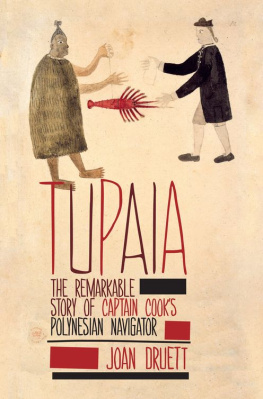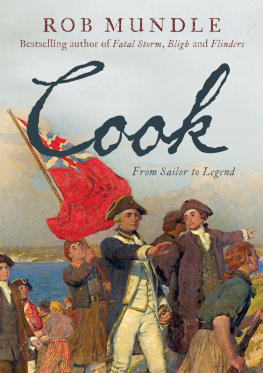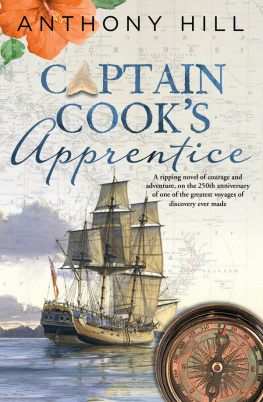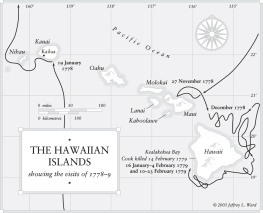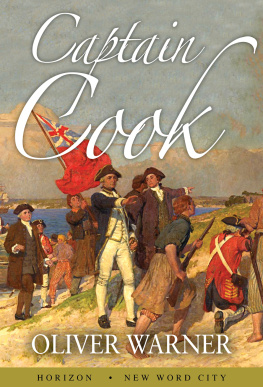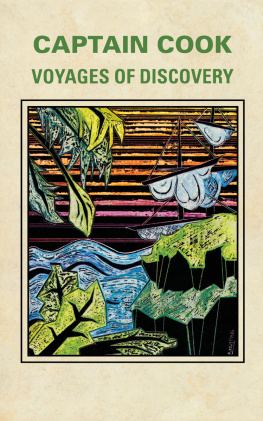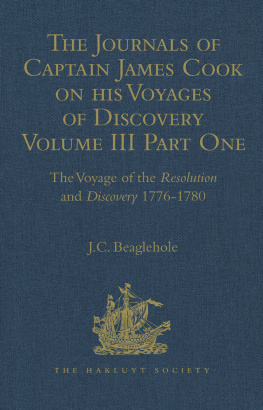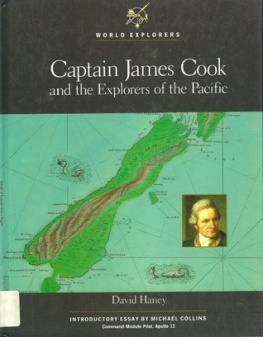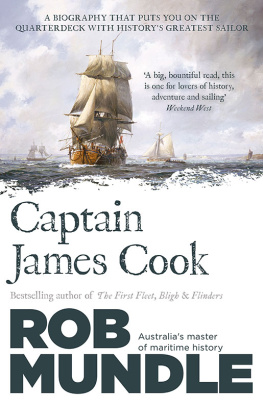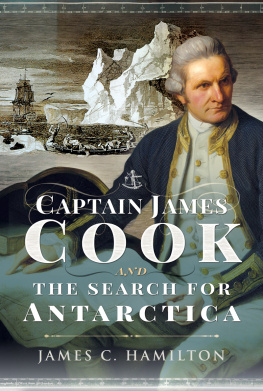Cook James - The life of Captain James Cook: the circumnavigator
Here you can read online Cook James - The life of Captain James Cook: the circumnavigator full text of the book (entire story) in english for free. Download pdf and epub, get meaning, cover and reviews about this ebook. City: Luton;Great Britain, year: 2012, publisher: Andrews UK, Ltd, genre: Home and family. Description of the work, (preface) as well as reviews are available. Best literature library LitArk.com created for fans of good reading and offers a wide selection of genres:
Romance novel
Science fiction
Adventure
Detective
Science
History
Home and family
Prose
Art
Politics
Computer
Non-fiction
Religion
Business
Children
Humor
Choose a favorite category and find really read worthwhile books. Enjoy immersion in the world of imagination, feel the emotions of the characters or learn something new for yourself, make an fascinating discovery.

- Book:The life of Captain James Cook: the circumnavigator
- Author:
- Publisher:Andrews UK, Ltd
- Genre:
- Year:2012
- City:Luton;Great Britain
- Rating:5 / 5
- Favourites:Add to favourites
- Your mark:
- 100
- 1
- 2
- 3
- 4
- 5
The life of Captain James Cook: the circumnavigator: summary, description and annotation
We offer to read an annotation, description, summary or preface (depends on what the author of the book "The life of Captain James Cook: the circumnavigator" wrote himself). If you haven't found the necessary information about the book — write in the comments, we will try to find it.
The life of Captain James Cook: the circumnavigator — read online for free the complete book (whole text) full work
Below is the text of the book, divided by pages. System saving the place of the last page read, allows you to conveniently read the book "The life of Captain James Cook: the circumnavigator" online for free, without having to search again every time where you left off. Put a bookmark, and you can go to the page where you finished reading at any time.
Font size:
Interval:
Bookmark:
THE LIFE OF CAPTAIN JAMES COOK
THE CIRCUMNAVIGATOR
BY ARTHUR KITSON
This edited version, including layout, typography, additions to text, cover artwork and other unique factors is copyright 2012 Andrews UK Limited
This book is sold subject to the condition that it shall not, by way of trade or otherwise, be lent, resold, hired out or otherwise circulated without the publishers prior written consent in any form of binding or cover other than that in which it is published, and without a similar condition being imposed on the subsequent purchaser.
PREFACE.
In publishing a popular edition of my work, Captain James Cook, R.N., F.R.S., it has, of course, been necessary to condense it, but care has been taken to omit nothing of importance, and at the same time a few slight errors have been corrected, and some new information has been added, chiefly relating to the disposition of documents.
I must not omit this opportunity of thanking the Reviewers for the extremely kind manner in which they all received the original work - a manner, indeed, which far exceeded my highest hopes.
ARTHUR KITSON.
LONDON, 1912.
JAMES COOK, R.N., F.R.S.
CHAPTER 1. EARLY YEARS.
James Cook, the Circumnavigator, was a native of the district of Cleveland, Yorkshire, but of his ancestry there is now very little satisfactory information to be obtained. Nichols, in his Topographer and Genealogist, suggests that "James Cooke, the celebrated mariner, was probably of common origin with the Stockton Cookes." His reason for the suggestion being that a branch of the family possessed a crayon portrait of some relation, which was supposed to resemble the great discoverer. He makes no explanation of the difference in spelling of the two names, and admits that the sailor's family was said to come from Scotland.
Dr. George Young, certainly the most reliable authority on Cook's early years, who published a Life in 1836, went to Whitby as Vicar about 1805, and claims to have obtained much information about his subject "through intercourse with his relatives, friends, and acquaintances, including one or two surviving school companions," and appears to be satisfied that Cook was of Scotch extraction. Dr. George Johnston, a very careful writer, states in his Natural History of the Eastern Borders, that in 1692 the father of James Thomson, the author of The Seasons, was minister of Ednam, Roxburghshire, and a man named John Cook was one of the Elders of the Kirk. This John Cook married, on the 19th January 1693, a woman named Jean Duncan, by whom he had a son, James, baptised 4th March 1694, and this child, Johnston positively asserts, was afterwards the father of the future Captain Cook. The dates of the marriage and baptism have been verified by the Reverend John Burleigh, minister of Ednam, and they agree with the probable date of the birth of Cook's father, for he died in 1778 at the age of eighty-five. Owing to the loss of the church records for some years after 1698, Mr. Burleigh is unable to trace when this James Cook left Ednam to "better himself," but he would take with him a "testificate of church membership" which might possibly, but not probably, still exist. Attracted, perhaps, by the number of Scotch people who flocked into the north of Yorkshire to follow the alum trade, then at its height, James Cook settled down and married; and the first positive information to be obtained is that he and his wife Grace (her maiden name has so far escaped identification, though she is known to have been a native of Cleveland) resided for some time at Morton, in the parish of Ormsby, and here their eldest child, John, was born in January 1727. Dr. Young says that James Cook had a superstition that his mother's farewell was prophetic of his marriage, for her words were "God send you Grace."
BIRTH-PLACE.
Shortly after the birth of John, the Cooks left Morton for Marton, a village a few miles away, and the similarity of the two names has caused some confusion. At Marton the father worked for a Mr. Mewburn, living in a small cottage built of mud, called in the district a clay biggin. This cottage was pulled down in 1786, when Major Rudd erected a mansion near the spot. Afterwards, when the mansion was burned to the ground, the site of the cottage was planted with trees, and was popularly known as Cook's Garth. Dr. Young was shown the spot by an old shoemaker whose wife's mother was present at Captain Cook's birth, and he says there was a willow-tree occupying the site, but no vestige of the walls was left. Mr. Bolckow, the present owner of Marton Hall, says: "The cottage was found destroyed when my uncle bought Marton in 1854, but we came across the foundations of it when the grounds were laid out." A granite vase has been erected on the spot. The pump which Besant says still exists, and was made by Cook's father to supply his house with water, was "put there after Cook's time," and has disappeared.
In this humble clay biggin James Cook, the Circumnavigator, was born on 27th October 1728, and was registered as baptised on 3rd November in the Marton church records, being entered as "ye son of a day labourer." He was one of several children, most of whom died young; John, the eldest, who lived till he was twenty-three, and Margaret, who married a Redcar fisherman named James Fleck, being the only two that came to maturity.
The Cooks remained at Marton for some years, during which time they removed to another cottage, and young James received some instruction from a Mistress Mary Walker, who taught him his letters and a little reading. Dr. Young and Kippis call her the village schoolmistress, but Ord, who was a descendant on his mother's side, says:
"she was the daughter of the wealthiest farmer in the neighbourhood, and wife of William Walker, a respectable yeoman of the first class residing at Marton Grange."
Young James, a lad of less than eight years old, worked for Mr. Walker:
"tended the stock, took the horses to water, and ran errands for the family, and in return for such services the good lady, finding him an intelligent, active youth, was pleased to teach him his alphabet and reading."
In 1736 Cook's father was appointed to the position of hind or bailiff by Mr. Skottowe, and removed with his family to Airy Holme Farm, near Ayton. According to Besant, a hind was one who, residing on a farm, was paid a regular wage for carrying on the work, and handed over the proceeds to the landlord. Young James, now eight years of age, was sent to the school on the High Green kept by a Mr. Pullen, where he was instructed in writing and arithmetic as far as the first few rules - "reading having apparently been acquired before." He is said to have shown a special aptitude for arithmetic, and it is believed that owing to the good reports of his progress, Mr. Skottowe paid for his schooling. According to Dr. Young, his schoolfellows gave him the character of being fond of his own way, and, when any project was on foot for birds-nesting or other boyish amusement, and discussion arose as to the method to be pursued, he would propound his own plans, and insist on their superiority; should his views not meet with approval, he would pertinaciously adhere to them, even at the risk of being abandoned by his companions.
STAITHES.
Most authorities say that Cook was bound apprentice to Mr. Saunderson, a grocer and haberdasher of Staithes, at the age of thirteen; but Mrs. Dodds, Saunderson's daughter, told Dr. Young that, after leaving school, he remained on the farm, helping his father, till 1745, when he was seventeen years old and then went to Staithes to her father on a verbal agreement without indentures, and would thus be free to leave or be discharged at any time.
The shop and house where he was engaged was situated about three hundred yards from the present slipway, and close to the sea, in fact so close that in 1812 it was threatened by the water, and was pulled down by Saunderson's successor, Mr. John Smailey, and the materials, as far as possible, were used in erecting the building in Church Street which is now pointed out as Cook's Shop. The late Mr. Waddington of Grosmont, near Whitby, says he visited Staithes in 1887 and found the original site covered by deep water. He was informed by an old man, who, as a boy, had assisted in removing the stock from the old shop, that not only were the stones used again in Church Street, but also most of the woodwork, including the present door with its iron knocker, at which, probably, Cook himself had knocked many a time.
Next pageFont size:
Interval:
Bookmark:
Similar books «The life of Captain James Cook: the circumnavigator»
Look at similar books to The life of Captain James Cook: the circumnavigator. We have selected literature similar in name and meaning in the hope of providing readers with more options to find new, interesting, not yet read works.
Discussion, reviews of the book The life of Captain James Cook: the circumnavigator and just readers' own opinions. Leave your comments, write what you think about the work, its meaning or the main characters. Specify what exactly you liked and what you didn't like, and why you think so.

